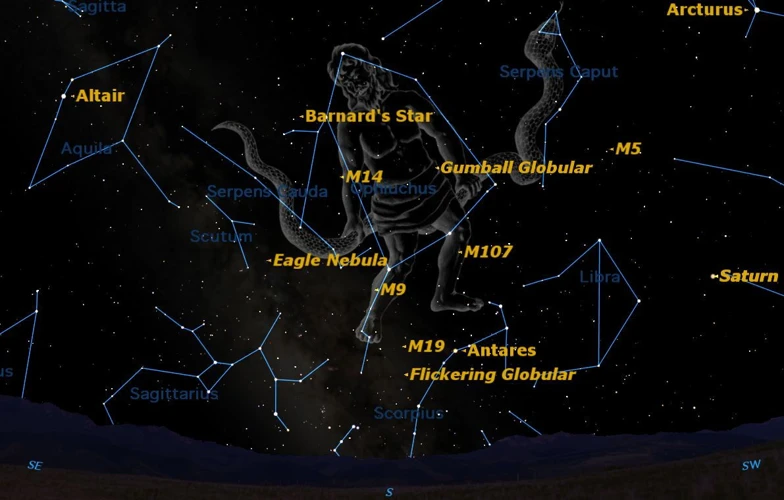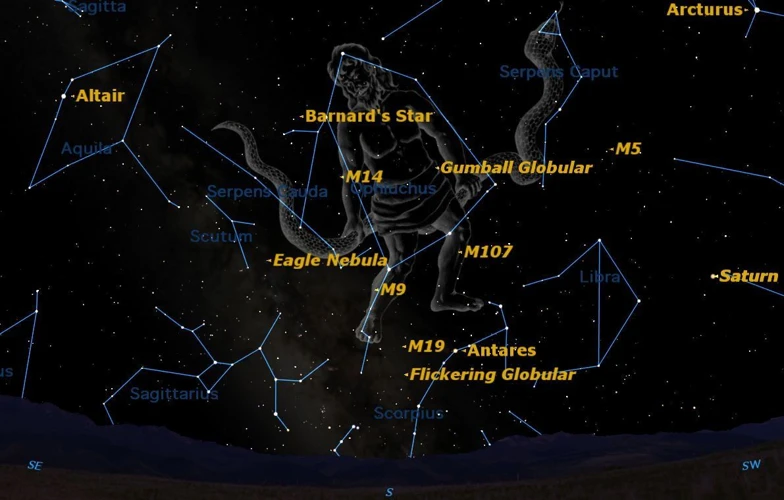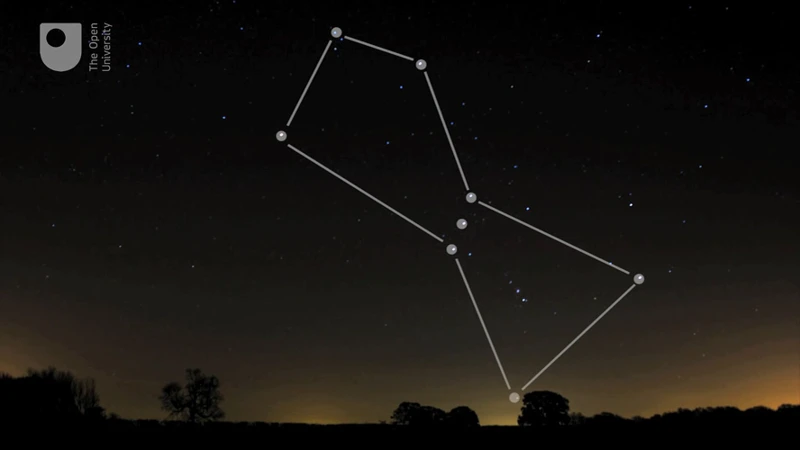The Big Dipper, a prominent constellation in the night sky, has fascinated cultures around the world for centuries. With its distinct shape resembling a ladle or a plow, the Big Dipper holds significant cultural, navigational, and astronomical value. From ancient times to the present day, different cultures have associated unique meanings and interpretations with this celestial formation. In this article, we will explore the rich history and symbolism of the Big Dipper in various cultures, its role in navigation techniques, and its significance in astrology and astronomy. Join us on this cosmic journey as we delve into the captivating world of the Big Dipper.
Contents
- The Big Dipper in Ancient Cultures
- The Big Dipper in Navigation
- The Big Dipper in Astrology and Astronomy
- Conclusion
-
Frequently Asked Questions
- What is the significance of the Big Dipper in different cultures?
- Why is the Big Dipper important in Greek mythology?
- How is the Big Dipper perceived in Chinese culture?
- What significance does the Big Dipper have in Native American folklore?
- How has the Big Dipper been used for navigation at sea?
- Has the Big Dipper been used in agriculture?
- What navigation techniques have indigenous cultures employed with the Big Dipper?
- What role does the Big Dipper play in astrology?
- How does the Big Dipper relate to stellar evolution?
- What impact has the Big Dipper had on space exploration?
- References
-
Frequently Asked Questions
- What is the Big Dipper and why is it significant?
- How did the Big Dipper get its name?
- What is the significance of the Big Dipper in Greek mythology?
- How is the Big Dipper depicted in Chinese culture?
- What is the significance of the Big Dipper in Native American folklore?
- How was the Big Dipper used for maritime navigation?
- How was the Big Dipper used for agricultural navigation?
- How did indigenous cultures use the Big Dipper for navigation?
- What is the significance of the Big Dipper in astrology?
- How does the Big Dipper relate to space exploration?
- References
- Read More
The Big Dipper in Ancient Cultures

The Big Dipper holds a significant place in ancient cultures, where it was often connected to mythology and divine symbolism. In Greek mythology, the Big Dipper was believed to be associated with the story of the Great Bear Callisto, who was transformed into a constellation by the goddess Hera. The seven stars of the Big Dipper represented Callisto and her son Arcas, and their eternal bond in the heavens. Similarly, in Chinese culture, the Big Dipper was seen as a celestial ruler and symbol of good fortune. It was often associated with the Emperor and considered a guardian of the north. Native American folklore also attributed spiritual and navigation significance to the Big Dipper, with different tribes interpreting it differently, including as a bear, a panther’s paw, or a group of ancestors guiding their people. Each culture’s interpretation of the Big Dipper showcases the profound impact of celestial objects on mythology and belief systems. [Internal link: Check out the mythical beliefs surrounding planetary alignments and their impact on cultures over time](/mythical-beliefs-planetary-alignment/).
The Big Dipper in Greek Mythology
In Greek mythology, the Big Dipper holds a captivating tale that centers around the story of Callisto and her transformation into a constellation. Callisto, a nymph and a follower of the goddess Artemis, caught the attention of Zeus, the king of gods. Zeus, disguised as Artemis, seduced Callisto, and she became pregnant with his child. When Artemis discovered Callisto’s pregnancy, she banished her from their group. Callisto, now a single mother, raised her son Arcas alone.
Hera, the wife of Zeus, grew jealous of Callisto and sought revenge. Taking advantage of a moment of vulnerability, Hera turned Callisto into a bear. Years later, when Arcas, now a young hunter, encountered Callisto in the form of a bear, he was about to kill her. However, Zeus intervened and transformed Arcas into a bear as well. In the night sky, these two bears were immortalized as the constellations Ursa Major and Ursa Minor, which include the seven stars known as the Big Dipper. Thus, the Big Dipper became a celestial representation of Callisto and her son Arcas, forever bonded in the heavens.
This myth reflects the Greeks’ fascination with the connections between mortal beings and the divine. The story of Callisto’s transformation and her eternal presence in the night sky captured their imagination and provided a spiritual explanation for the existence of the Big Dipper constellation. [Internal link: Dive deeper into the intriguing creation stories of various mythologies, like the Hindu creation story](/creation-story-hindu-mythology/).
The Big Dipper in Chinese Culture
The Big Dipper, known as the “Northern Dipper” in Chinese culture, holds immense significance and symbolism. It is considered one of the most important and revered constellations in Chinese astronomy and astrology. In Chinese cosmology, the seven stars of the Big Dipper were believed to represent the seven divine beings or deities who held influential roles in the celestial realm. The handle of the ladle was seen as a celestial axis connecting the Earth and the heavens, with the dipper itself symbolizing the Emperor’s power and authority. The Big Dipper’s position in the night sky was used for various practical purposes as well. It was used as a navigational tool, helping travelers determine directions, especially during the ancient times when compasses were not widely available. Additionally, the divination practice of Feng Shui often made use of the Big Dipper’s alignment to determine auspicious directions and placements. The significance of the Big Dipper in Chinese culture is deeply ingrained and has influenced various aspects of Chinese beliefs, traditions, and even architecture. [Internal link: Explore the hidden meanings and analysis of the Virgo Code](/virgo-code-analysis/) to further understand the intricate connections between celestial objects and cultural interpretations.
The Big Dipper in Native American Folklore
The Big Dipper holds a special place in Native American folklore, where it is seen as a significant and sacred constellation. Various indigenous tribes across North America have their own unique stories and interpretations of the Big Dipper. In some tribes, it is believed to represent a bear, known as the Great Bear or the Great Sky Bear, and its position in the sky indicates the changing seasons. The bear symbolizes power, strength, and knowledge. According to the Anishinaabe people, the Big Dipper is seen as a celestial campfire around which the warriors and hunters gather in the sky. The Ojibwe tribe sees the constellation as a guide for travelers, both in the physical and spiritual realms. To some Native American tribes, the Big Dipper is an integral part of their creation stories, connecting them to their ancestors and the natural world. It is considered a symbol of guidance, protection, and spiritual alignment. The rich and diverse mythology surrounding the Big Dipper in Native American folklore reflects the deep connection between the indigenous cultures and the celestial realm.

The Big Dipper has played a crucial role in various forms of navigation throughout history. In maritime navigation, sailors have relied on the Big Dipper’s position to determine their latitude in the northern hemisphere. By identifying the two stars at the end of the Big Dipper’s bowl, they could navigate their ships along the correct latitude line. Additionally, in agricultural navigation, farmers have used the Big Dipper as a seasonal guide. Its position in the night sky helped them determine the appropriate time for planting and harvesting crops. Indigenous cultures around the world have incorporated the Big Dipper into their navigation techniques. For example, Polynesian navigators used the Big Dipper, along with other constellations, to navigate across vast expanses of the Pacific Ocean. The significance of the Big Dipper in navigation showcases its practical utility in guiding explorers, farmers, and seafarers throughout history.
The Big Dipper played a crucial role in maritime navigation, guiding sailors across vast oceans in ancient times. Sailors would rely on this constellation as a navigational aid to determine their latitude and ensure they were on the correct course. By observing the position of the Big Dipper, sailors could gauge their distance from the North Star, Polaris. As the Big Dipper rotates around Polaris throughout the night, sailors could estimate their approximate latitude by measuring the angle between the horizon and the height of the Big Dipper. This method, known as celestial navigation, was particularly useful when other navigational tools were not available or unreliable. Sailors would also use the Big Dipper as a reference point to navigate other stars and constellations, ultimately guiding them to their destination. The Big Dipper’s importance in maritime navigation cannot be overstated, as it provided a reliable celestial guide to explorers and seafarers charting the unknown waters of the world’s oceans.
The Big Dipper has played a crucial role in agricultural navigation for centuries. In agriculture, the proper timing of planting and harvesting crops is essential for a successful harvest. Ancient farmers recognized the correlation between the position of the stars and the changing seasons, and they used the Big Dipper as a guide for their agricultural activities. By observing the position and movement of the Big Dipper throughout the year, farmers could determine the optimal time to sow their seeds and reap their crops.
The rotation of the Big Dipper around the North Star, Polaris, helped farmers identify the changing seasons and track the progression of time. As the Big Dipper revolves counterclockwise around Polaris, its position in the night sky changes subtly. These celestial movements served as a natural calendar for agricultural communities, indicating when to prepare the soil, plant seeds, and reap the rewards of their labor.
Farmers would look for specific alignments and patterns of the Big Dipper to establish the best timing for their agricultural practices. For example, when the handle of the Big Dipper pointed downward, it signaled the beginning of the planting season. This alignment indicated that the ground had thawed and was ready for seeding. Conversely, when the handle of the Big Dipper pointed upward, it indicated the end of the growing season and the approaching time for harvest.
The Big Dipper provided a dependable and easily recognizable reference point for agricultural navigation. It allowed farmers to synchronize their activities with the natural rhythms of the sky and maximize their chances of a bountiful crop. These ancient agricultural practices, guided by the movements of the Big Dipper, highlight the deep connection between celestial observations and the cultivation of the land. The reliance on the Big Dipper for agricultural navigation underscores the practical wisdom and ingenuity of our ancestors in harmonizing with the celestial realm.
The Big Dipper played a crucial role in indigenous navigation techniques across various cultures around the world. Indigenous peoples developed sophisticated methods of using the stars, including the Big Dipper, to navigate their lands and waters. One such technique involved locating the North Star by using the two outermost stars of the Big Dipper’s bowl as a guide. By drawing an imaginary line from these stars, they could find Polaris, also known as the North Star, which stays nearly fixed in the sky and points towards the Earth’s North Pole. This knowledge allowed indigenous navigators to determine their direction, even in unfamiliar territories. In addition to finding the North Star, indigenous cultures also used the Big Dipper as a pathfinder for other important stars and constellations. By following the curve of the Big Dipper’s handle, they could locate other stars and constellations that were used as navigational markers. This technique provided them with a mental map of the night sky, enabling them to navigate vast distances, explore new lands, and engage in trade and cultural exchanges. The Big Dipper’s prominence and easily recognizable shape made it an invaluable tool for indigenous navigation, fostering a deep connection between the stars and their daily lives.
The Big Dipper in Astrology and Astronomy

The Big Dipper plays a significant role in both astrology and astronomy, captivating the curiosity of stargazers and scientists alike. In astrology, the Big Dipper is often associated with strength, abundance, and protection. It is believed to have a powerful influence on one’s destiny and is considered lucky for those born under its celestial influence. Astronomically, the Big Dipper is an asterism—a recognizable pattern within a constellation—within the Ursa Major constellation. While it doesn’t hold any specific scientific significance, it serves as a helpful celestial pointer. The two pointer stars in the bowl of the Big Dipper lead to the North Star, Polaris, aiding navigators and astronomers in finding their bearings. The Big Dipper’s position in the northern hemisphere makes it a constant presence in the night sky, offering a familiar and reliable reference point for astronomers and enthusiasts alike. Whether gazing through a telescope or consulting astrological charts, the enigmatic allure of the Big Dipper continues to inspire and captivate our imaginations.
The Big Dipper in Astrological Interpretations
The Big Dipper’s presence in the night sky has fascinated astrologers throughout history, leading to various interpretations and significances. In astrological interpretations, the Big Dipper is often associated with abundance, protection, and divine guidance. Its seven stars are seen as symbolic representations of the seven classical planets, each carrying its own astrological influence. For instance, the star Alcor is linked to success and prosperity, while Mizar is associated with intuition and spiritual awakening. People born under the influence of the Big Dipper are believed to possess charismatic qualities and a strong connection to the spiritual realm. Astrologers suggest that the positioning of the Big Dipper in an individual’s birth chart can provide insight into their life’s purpose and destiny. The constellation is closely linked to the North Star, Polaris, which serves as a navigational beacon. In astrology, Polaris is considered a guiding light, symbolizing direction and stability in one’s life journey. The Big Dipper’s presence in astrological interpretations signifies a celestial connection and the potential for profound personal growth and guidance.
The Big Dipper in Stellar Evolution
The Big Dipper, also known as Ursa Major, plays a fascinating role in stellar evolution. This constellation is home to several notable stars, including the famous asterism known as the “Big Dipper’s handle.” These stars are part of a larger stellar group called an open cluster, known as the Ursa Major Moving Group, which shares a common origin and motion through space. The stars that make up the Big Dipper are relatively young, ranging from 50 to 150 million years old. They are primarily classified as spectral type A and F, representing young, hot, and massive stars. Further, the Big Dipper also contains a diverse set of stellar stages, showcasing different phases of evolution. Two notable examples are Mizar and Alcor. Mizar, the middle star of the Big Dipper’s handle, is actually a triple star system consisting of two binary stars. Alcor, located next to Mizar, is also a binary star. These systems provide scientists with valuable insights into stellar formation and the dynamics of multiple star systems. The Big Dipper serves as a reference point for astronomers to study stellar evolution and better understand the life cycles of stars, from their formation to their eventual demise. This constellation’s prominence and accessibility make it a valuable tool for both amateur stargazers and professional astronomers seeking to unravel the mysteries of our universe.
The Big Dipper in Space Exploration
The Big Dipper has played a role in space exploration, aiding scientists and astronauts in their missions beyond Earth’s atmosphere. Here are some interesting aspects of the Big Dipper’s connection to space exploration:
1. Spacecraft Navigation: The Big Dipper has been utilized as a navigational reference point by spacecraft. Its position in the sky has helped guide space probes and satellites as they traverse the vastness of space. By aligning their trajectory with the Big Dipper’s stars, spacecraft can maintain a stable course and accurately reach their intended destinations.
2. Orbital Insertion: When spacecraft enter orbit around celestial bodies, such as planets or moons, they often rely on the Big Dipper for guidance during the critical stage of orbital insertion. By aligning their trajectory with specific stars of the Big Dipper, scientists and engineers can ensure that the spacecraft enters the desired orbit and adjusts its speed and direction accordingly.
3. Deep Space Missions: In deep space missions, where communication with Earth may be limited, the Big Dipper serves as a celestial navigation tool. Spacecraft can use the positions of the Big Dipper’s stars to determine their own orientation and make necessary course corrections. This information allows them to stay on track and maintain proper alignment with their mission objectives.
4. Exploration of Unknown Territories: The Big Dipper has also helped scientists explore unknown territories in space. By mapping the positions and movements of the stars in the Big Dipper, astronomers can uncover new information about the universe, such as the formation of galaxies, the behavior of black holes, or the existence of exoplanets. The Big Dipper serves as a guide and reference point in astronomical observations, enabling researchers to make significant discoveries.
The utilization of the Big Dipper in space exploration highlights the remarkable connection between the celestial realm and human endeavors to explore and understand the vastness of the universe. By relying on the positions and movements of these stars, scientists and astronauts can navigate the complexities of space travel and gain invaluable insights into our cosmic surroundings.
Conclusion

In conclusion, the significance of the Big Dipper in different cultures is a testament to the universal fascination with the night sky and our desire to understand the celestial realm. From the ancient Greeks to the Chinese and Native Americans, the Big Dipper has served as a source of inspiration, mythology, and navigation. Its prominent place in cultural narratives showcases the human need to assign meaning and purpose to the natural world. Additionally, the Big Dipper’s role in navigation, both maritime and agricultural, highlights its practical importance in guiding travelers and farmers alike. Furthermore, in the realm of astrology and astronomy, the Big Dipper continues to captivate scientists and enthusiasts with its stellar evolution and its potential role in space exploration. Its distinct shape and visibility make it a recognizable and cherished constellation for stargazers around the world. As we gaze up at the night sky and behold the beauty of the Big Dipper, we are reminded of its timeless significance and its ability to connect us to the celestial wonders beyond.
Frequently Asked Questions

What is the significance of the Big Dipper in different cultures?
The Big Dipper holds significant cultural symbolism in various civilizations. It is associated with mythology, navigation, and astronomy, and its meaning varies across cultures.
Why is the Big Dipper important in Greek mythology?
In Greek mythology, the Big Dipper represents the story of Callisto and her son Arcas. The constellation holds a prominent place in their eternal bond and is associated with the protection of the divine.
How is the Big Dipper perceived in Chinese culture?
In Chinese culture, the Big Dipper is seen as a celestial ruler and a symbol of good fortune. It is often connected to the Emperor and is considered a guardian of the north.
What significance does the Big Dipper have in Native American folklore?
In Native American folklore, the Big Dipper carries various interpretations among different tribes. It can represent a bear, a panther’s paw, or even a group of ancestors guiding their people.
The Big Dipper has been a reliable navigational tool for mariners throughout history. Its position in the night sky helps sailors determine their latitude and navigate across vast oceans.
Has the Big Dipper been used in agriculture?
Yes, the Big Dipper has also been used in agricultural navigation. By observing the position and movement of the Big Dipper, farmers could determine planting and harvesting seasons, and even predict weather patterns.
Indigenous cultures have developed unique navigation techniques using the Big Dipper. For example, Polynesian wayfinders would use the stars of the Big Dipper as reference points to navigate long distances across the open ocean.
What role does the Big Dipper play in astrology?
In astrology, the Big Dipper is associated with various interpretations. It symbolizes guidance, protection, and transformation, and its positioning in astrological charts can influence personal traits and destinies.
How does the Big Dipper relate to stellar evolution?
The Big Dipper itself is not directly related to stellar evolution. However, as individual stars within the constellation go through their lifecycle, they may evolve into different stages, providing valuable insights into the processes of stellar evolution.
What impact has the Big Dipper had on space exploration?
The Big Dipper has not directly impacted space exploration. However, its familiarity in the night sky has helped space enthusiasts and astronomers locate and identify other celestial objects, facilitating our understanding of the universe.
References
Frequently Asked Questions

What is the Big Dipper and why is it significant?
The Big Dipper is a prominent star pattern in the northern celestial sky. It is significant because it has been a point of fascination and cultural significance in various civilizations throughout history.
How did the Big Dipper get its name?
The Big Dipper derived its name from its distinct shape, resembling a ladle or dipper. The word “Big” indicates its larger size compared to the Little Dipper.
What is the significance of the Big Dipper in Greek mythology?
In Greek mythology, the Big Dipper represents the tale of Callisto, a nymph who was transformed into a bear by the goddess Hera. The constellation Ursa Major, which includes the Big Dipper, is associated with this mythological story.
How is the Big Dipper depicted in Chinese culture?
In Chinese culture, the Big Dipper is known as the “Northern Dipper” and was associated with the Taoist deity Doumu. It is considered a symbol of luck, divinity, and protection, often depicted in Chinese art and architecture.
What is the significance of the Big Dipper in Native American folklore?
Native American tribes have various legends and interpretations surrounding the Big Dipper. Some see it as a bear, while others view it as a group of hunters or a celestial tool for storytelling and navigation.
The Big Dipper served as a navigational tool for sailors. By locating the North Star and using the pointer stars of the Big Dipper, sailors could determine their latitude and navigate the seas.
In agriculture, the Big Dipper was used as a guide for planting and harvesting crops. Farmers would observe its position in the sky to determine the best time for sowing seeds or reaping the harvest.
Indigenous cultures around the world had their navigation techniques. Some used the Big Dipper as a reference point to navigate their surroundings, study seasonal changes, and track migratory patterns of animals.
What is the significance of the Big Dipper in astrology?
In astrology, the Big Dipper has various interpretations depending on different belief systems. It can symbolize guidance, protection, and spiritual insight, influencing horoscopes and astrological readings.
How does the Big Dipper relate to space exploration?
The Big Dipper plays a significant role in space exploration as it has been used by astronomers to discover and study other celestial bodies. It serves as a point of reference for locating galaxies, stars, and other astronomical objects.







